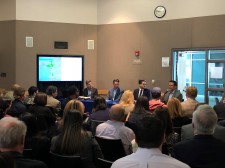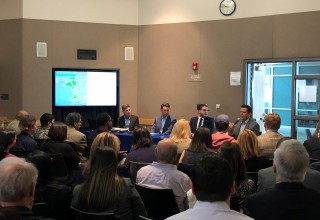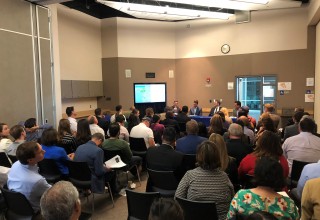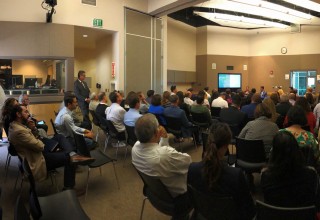Community Leaders Gather in South County to Learn More About San Diego's Opportunity Zones

SAN DIEGO, November 21, 2018 (Newswire.com) - Last week, panelists and guest speakers came together to discuss and expand on San Diego’s Opportunity Zones and how investing in these zones can qualify for preferential tax benefits while contributing to the local economy. This new investment program connects private capital with economically distressed communities. South County Economic Development Council and event sponsor Civic San Diego organized the 2018 Opportunity Zone Forum to encourage community leaders and members to learn more about this important subject to start getting involved in the program.
Michael Lengyel, assistant vice president of Civic San Diego; Bryndan Stueve, program officer of LICS San Diego; Eric Tetrault, associate at Higgs Fletcher & Mack; and Brad Raulston, deputy city manager of the city of National City, rounded out the Opportunity Zones panel.
South County and San Diego County's growth is booming in all aspects and this new program offers incentives not only on a personal level as an investor but also for the community as a whole. South County EDC urges community members to learn more about the exciting program and take advantage of the opportunities around our area.
Cindy Gompper-Graves, President and CEO of South County EDC
“We are extremely happy to sponsor the Opportunity Zones Forum with South County EDC,” said Michael Lengyel, assistant vice president of Civic San Diego. “Investing in Opportunity Zones in South County and San Diego offers great potential for investors and low-income communities alike, and it is important to start taking advantage of this opportunity.”
An overflowing crowd of more than 75 community members, including elected officials, investors, developers and more from around San Diego County as well as all the way from Calexico, gathered at the South County Regional Education Center to learn more about Opportunity Zones in South County and San Diego County. The forum offered attendees a comprehensive look into the new program, which was enacted as part of the Tax Cut and Jobs Act, effective in December of 2017.
Eric D. Tetrault dove into what the Opportunity Zones are, what the benefits and requirements include and why they should be taken advantage of. The new law focuses on finding and appointing Opportunity Zones throughout the region, which are chosen based on a census tract identifying low-income communities. Among those Opportunity Zones are National City, Chula Vista, Downtown San Diego and El Cajon. The law also enables tax incentives for investments in these zones, including the deferral, and possible elimination, of capital gains that are reinvested in the zones.
“Opportunity Zones are especially attractive to institutional investors or 'impact' investors – those who are interested in providing a real difference in the community,” said Tetrault. “These possibilities give investors that have a stake and interest in seeing their community grow the chance to do so with extra incentives.”
Some of the benefits an investor is eligible for are tax deferrals on capital gains invested in a qualified opportunity fund and if those capital gains are held in the qualified opportunity fund for at least 10 years, it may elect to increase the basis of the investment to fair market value when sold, which eliminates all gain. This case can also be available for five years and seven years, which at five years one is eligible to increase the basis in investment by 10 percent of gain deferred and at seven years becomes eligible by an additional five percent (15 percent) of gain deferred. Tetrault also talked about the requirements, which include, but are not limited to, a 180-day limit to invest capital gains in a qualified opportunity fund (of the capital gain event).
Brydan Stueve was also present to discuss the work that Local Initiatives Support Corporation (LISC) does and how they tie in with the Opportunity Zones. LISC is a national organization that dedicates their efforts to ameliorating communities to become good places to work, do business and live. LISC’s success in San Diego includes creating affordable housing, financial opportunity centers, neighborhood economic development and more. “The Opportunity Zone is a new tool in San Diego’s investment toolbox to direct more resources into the communities where we work,” said Stueve.
Brad Raulston, from the city of National City, spoke to the promising area of National City, highlighting its opportunistic location between bustling Downtown San Diego and the busiest international border in the United States. Raulston talked about the impact that housing has and how San Diego ultimately needs to concentrate their efforts as its popularity grows. National City is home to the Naval Base San Diego, which has 30,000 active-duty sailors and is expected to grow about 10 percent in the next five years, which means there is a need for more housing and space and represents their biggest demand group.
“We are working on several projects in downtown [National City]. There is this term 'micro-units,'” said Raulston. “This is something that is happening all over the world in urban environments when you think about designing smaller and livable units. We’ve been working a lot on this project, including amenities – but we think that National City already has all of the necessary amenities.”
The panel then answered questions from the attendees and continued to emphasize the opportunity at hand and the importance it holds for the overall growth of San Diego.
For more information on the Opportunity Zone Forum and upcoming South County events and development, visit www.southcountyedc.com or email scedc@southcountyedc.com.
Source: South County EDC



